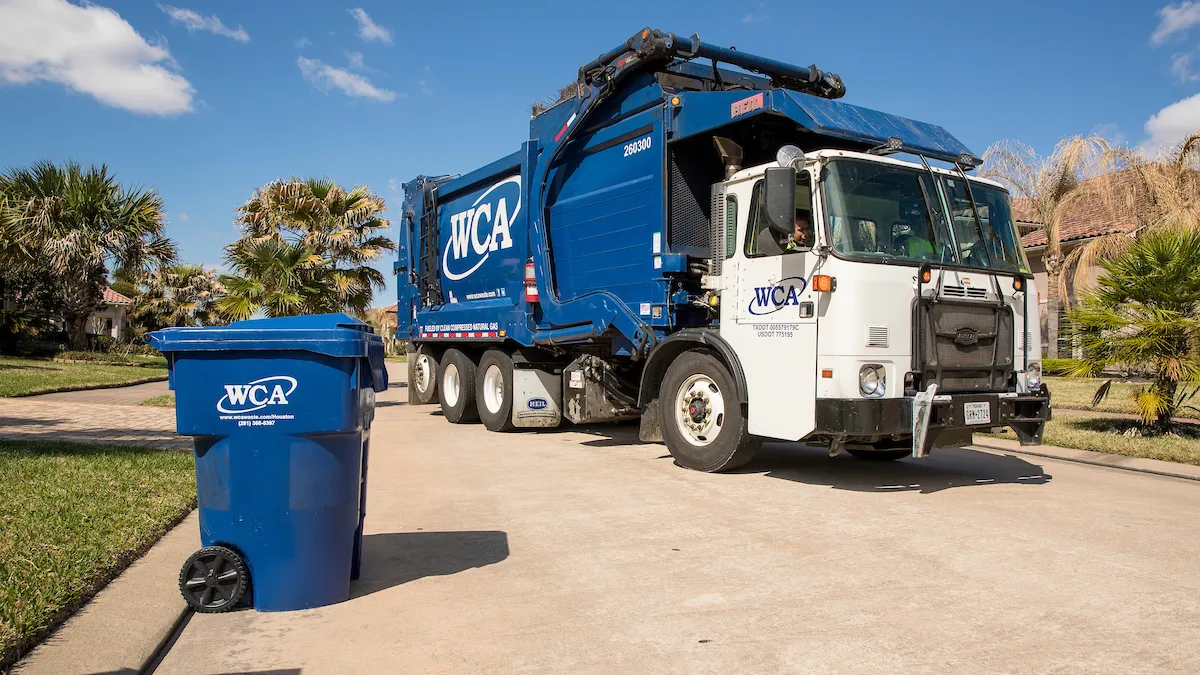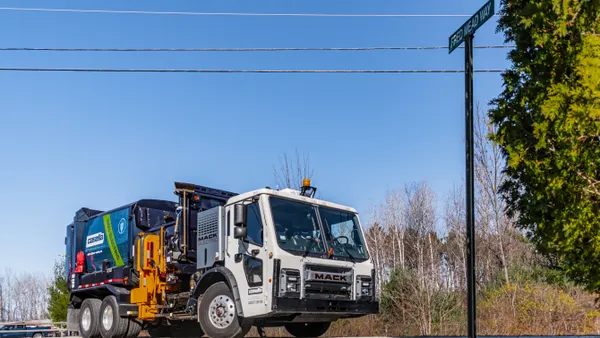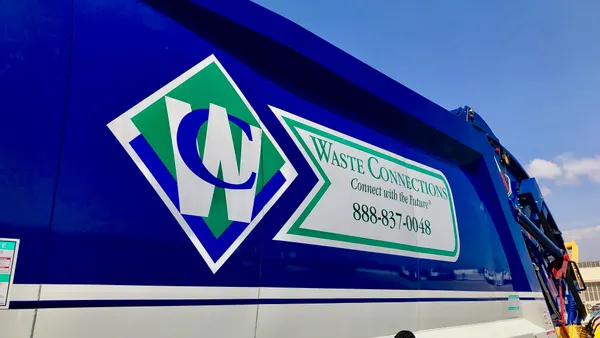Dive Brief:
- Texas-based WCA Waste recently set new 2030 sustainability goals that include plans to reduce greenhouse gas emissions (GHG) 35% by shifting more of its fleet to compressed natural gas (CNG) and mitigating landfill emissions. Baseline carbon accounting data is expected to be released next year. The company also aims increase its recovery of recyclables by 50%.
- WCA's fleet currently comprises 16% CNG vehicles, but the company expects it could increase that to at least 50%. CEO Bill Caesar told Waste Dive he sees opportunities for new or expanded fueling infrastructure in Houston, Kansas City, Missouri and parts of Florida.
- ESG is still seen as an evolving area for the sector and WCA's move comes as some other large players have still not set specific targets or pledged to publish carbon accounting data. WCA describes itself as the eighth largest non-hazardous solid waste collection and disposal company in North America, reporting $400 million in annual revenue in this latest report.
Dive Insight:
WCA reported partial or full progress toward multiple goals set in its first report last year around route optimization, leachate management, recycling quality, employee relations and community engagement. Caesar said that initial report came from an internal analysis of existing operations through the environmental, social and governance (ESG) lens, rather than any investor pressure or seeking positive optics.
“[It] wasn’t driven by a desire to simply reduce carbon footprint, it was really a dual goal. It was what are the things that we can do as a company that will allow us to support the environment, and at the same time either reduce our costs or do something that helps us improve our customer service in some way," said Caesar. “I don’t think it’s that hard to get to both of those things."
In addition to its environmental goals, WCA aims to have zero lost time injuries and reduce its OSHA Total Recordable Incident Rate to at least 2.5 (from 3.7 in 2018 and 4.6 in 2019) by 2030. Increasing use of technology and improving employee engagement are factors in that effort. The company is also working to reach a 20% voluntary turnover rate (as compared to 31% in 2018 and 27.76% in 2019). Finally, it plans to make $250,000 in charitable contributions each year and participate in "annual dedicated volunteer efforts."
For this second report, which Caesar personally wrote much of, WCA informed its strategy by focusing on four key United Nations Sustainable Development Goals (SDGs) and chose to set a smaller list of new goals over a longer timeframe so "we can factor that into our investment assessments and our capital expenditure planning." Like other vertically-integrated operators in the industry, WCA sees its fleet and landfills as among the largest sources of GHG emissions.
WCA's share of smaller operations with less than 25 trucks means it won't be able to justify the investment in CNG fueling infrastructure at every site, but Caesar sees a clear path in denser markets. While its share of CNG vehicles was once more than 20%, that dropped slightly following acquisitions in recent years because "the chances that a smaller company is using CNG trucks is pretty small." Scientists and environmental groups have expressed skepticism about the climate benefits of CNG, a point Caesar recognized, although many agree it is preferable to diesel emissions. Caesar said he does not anticipate alternatives such as electric vehicles will be viable at scale near term.
On the landfill side, WCA currently has 22 sites and four gas-to-energy projects. Additional sites will be reaching sufficient scale to justify investment in more technology to convert the gas into various forms of energy in the coming years, Caesar said. At the same time, when looking through the lens of SDG trends around urban growth, the company's report indicates it will need to move to "secure/expand disposal capacity at WCA landfills near large metropolitan areas to support long-term growth."
Asked whether that move could offset emissions reduction efforts, Caesar said increases in landfill capacity and population growth do drive up GHG emissions but that can be mitigated. Though as discussed with Waste Dive last year, Caesar does not anticipate near-term market changes when it comes to more organics diversion or other alternative approaches in the areas where WCA currently operates.
“I would love for us to get to the point where we’re not focusing on landfill capacity, we’re focusing on conversion technology capacity, but we’re just not there yet," said Caesar. "In the meantime, the trash has to go somewhere. And we’re not going to be the ones investing in those technologies, we’ll be the ones that will be taking those technologies once they’re commercialized and implementing them."
At the same time, WCA does see opportunities to increase its relatively limited presence in recycling as population growth continues in certain markets. The company could increase throughput by 30-40% at its Kansas City MRF (which will soon have new automated systems installed by AMP Robotics) and upward of 50% at its Houston MRF as demand grows, Caesar said.
Larger players Waste Management and Republic Services have set their own GHG reduction targets in recent years, amid mounting concerns around climate change, and GFL Environmental recently pledged to do so. Caesar said he thinks this is an attainable step for other companies of scale and touted the ESG framework as a useful structure for thinking holistically about goals many in the industry already share.
“Frankly, if I can deliver against the safety targets, if I can deliver against the turnover targets and the community partnership targets and I miss the GHG [target], I will still consider that a huge victory because those things to me are as important," he said, noting turnover as a high priority. “If we as an industry can get better on that one metric, we as an industry will get better in a lot of other ways.”












